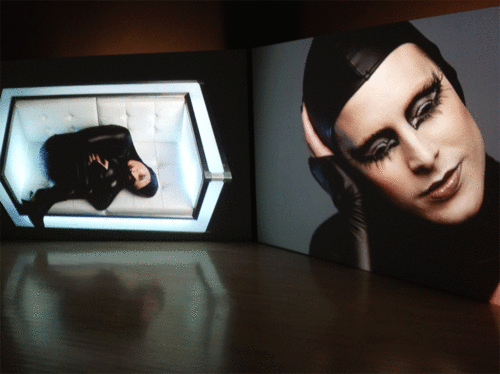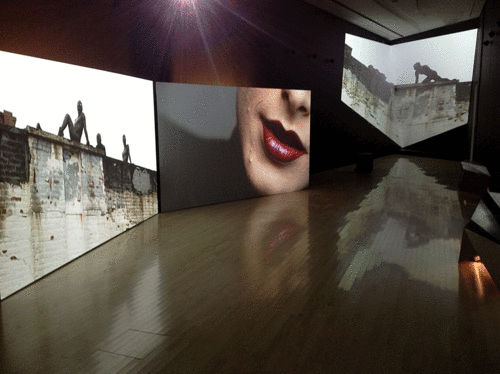Meet a NYFA Artist: Michelle Handelman
NYFA talks to Michelle Handelman (NYFA Fellow in Video, 2010) about the shadows where she finds meaning, living “undercover,” and her current installation, Irma Vep, the last breath, which is at The Eli and Edythe Broad Art Museum at Michigan State University through March 30th.
NYFA: Congratulations on the extension of your exhibition, Irma Vep, the last breath, at the Broad Museum at Michigan State University. Tell us about the installation. Why Irma Vep? What drew you to that character?
MH: When I was a teenager, I was obsessed with German Expressionism and silent film. Naturally, I was drawn to the classics such as The Cabinet of Dr. Caligari and Metropolis, but when I saw Feuillade’s Les Vampires, I became transfixed by the image of Irma Vep. Who was this woman dressed in a black catsuit slinking around Parisian rooftops always on the run? She had this aura about her that was mysterious and intelligent, and she totally looked like she was up to no good!
As I got deeper into this project, I realized that part of my attraction to her was because I was Irma Vep. She was me. Irma’s a criminal; a working-class hero who’s on a mission to usurp the ruling class. When I was young, my parents split up and my father left middle-class suburbia to, shall we say, live outside the law, live outside the system, and I was his accomplice. I learned early on how to live life undercover and how to present something other than the truth.
NYFA: So, the piece is personal to you?
MH: All of my work comes from my life, even when it comes from literature or film.
NYFA: How did you decide to cast Zackary Drucker and Jack Doroshow for the lead roles?
MH: We all live undercover to some degree, but some of us are doing it more consciously. As a trans woman, Zackary has lived much of her life undercover as the wrong gender, and now she is living her life undercover as the right gender. Jack is a legendary drag queen who grew up during the 1950s and knows a thing or two about living undercover, both as a form of protection and as resistance to mainstream culture. But the real key is that Zackary and Jack’s personal relationship to one another runs very deep, and Irma Vep, the last breath is in part an homage to their relationship.
NYFA: It’s interesting how you structured the piece around a therapy session between Irma Vep and her therapist. How did you come up with that idea?
MH: I love playing with the idea of a work of art having its own life like a living, breathing entity. I mean, my art gets to visit far more interesting places than I do! So in thinking about Irma Vep, I started to think … What if she was a real person? What goes on inside her mind? You know, what does she do in her downtime? I mean, she’s got quite a life going on here! What would she talk to her therapist about? And then I realized that positioning my piece around a therapy session would be a perfect way to get to the existential nature of this cinematic construction. The masked woman unmasked, so to speak. The therapist dialogues are really an amalgamation of my own issues, Zackary’s issues, and what I imagine Irma Vep’s issues to be — specific to her situations in the film.
NYFA: You have said that your work has always been intertwined with sex and death. Why have these concepts remained a constant for you?
MH: Eros and Thanatos, what else is there? The drive for pleasure and the fear of death. From a very early age, I lost a lot of people with whom I was close, and that left me navigating the world of human suffering on a deeply personal level. Nothing seemed worthwhile, but art provided me with some hope, some proof that beauty could arise out of violence and chaos. From the beginning, I’ve made work that’s a pouring out of my own existential questioning. The shadows are where I find meaning.
My work vacillates between the psychological and the intellectual, the physical and the intangible, the raw and the formal. I don’t feel I’ve resolved anything; I just keep getting deeper. Even though it’s very personal, I know these issues are universal, and I hope my work gets people to confront their own fears while still evoking a deep empathy —that I’ve made something that moves them.
NYFA: Artists have different reactions to approaching new projects. Some view the tabula rasa (blank slate) as liberating, while others are routinely terrified of the process of getting started. How do you react to the tabula rasa, and how does your process tend to play out from start to finish?
MH: I tend to work on my projects for a long time — for years. When I finish something, I usually take a break because I feel so emptied out, and during this break I start to consume everything I’ve missed: movies, books, exhibitions, people. I go into what I call “sponge mode.” I’ve wrung myself dry; now it’s time to suck in everything.
Then something will start a spark. Either it’s a performer I want to work with, or a color I’m obsessing over, or a quote that’s rocked my world — something will start the fire, and from there I start my research, which usually means immersing myself in every book, film or conversation that’s connected to this spark. I cull lots of images from the web, from magazines, and then I stick all of those images up on a board in my studio. Then I’ll hole up in my studio staring at these images, pore over my materials, play loud music, and drink lots of wine till the magic formula comes to me. It’s pretty intuitive.

NYFA: In another interview, you referred to the moment when you first began to think of yourself as a “serious artist.” How do you define a “serious artist”?
MH: A serious artist is an artist who knows they have no other choice but to do what they do. And they do it with conviction.
NYFA: Let’s talk about your audience/who you are trying to reach with your work. Is that a factor you consider during the creative process? Are you ever surprised by people’s reactions to your work?
MH: I hate that question on grant proposals when they ask you, “who is your desired audience”? Well, everyone, right? Don’t we all want our art to reach as many people as possible? I’ve been doing this long enough to know you can’t control the audience’s response, and in most situations you can’t control who the audience is. That said, I thoroughly understand the effect my work has on people, because I’ve been censored many times and have had to defend my work to large groups of people. And plenty of times, the things that offend people are not the things you imagine. So when working on a project, I may be in the middle of shoot and half-jokingly say, “They’re gonna rake me over the coals for this,“ but I never let that awareness stop me.
NYFA: You have a BFA from San Francisco Art Institute and an MFA from Bard. Frequently artists express mixed feelings about their art school experiences. How would you describe your time in art school?
MH: You have to understand: I dropped in and out of college many times before getting my BFA, and then it was many years after that when I decided to go to grad school. Traveling the world and finding myself in strange places with strange people was my real education. Art school gave me the time in which to build projects with the materials of life I had already gathered. It was also the place where I met my best friends and for that I am forever grateful.
NYFA: Congratulations on your new endeavor of developing a film and media program at FIT (Fashion Institute of Technology) in New York City. How has your own experience as a student affected your approach to the role of college professor?
MH: It’s interesting because I’m very critical of institutional structures and never did I ever think I would become part of the academic institution. I never bought into the idea of going straight from high school to college to grad school to professor-dom. I mean, what on earth would you have to teach anyone other than regurgitated information? So as an institutional interloper, I find it’s my job to bring a dose of reality to the classroom — to get students to think about not what kind of career they want, but what kind of life they want for themselves. It’s exciting being part of this new endeavor at FIT. They’re committed to expanding the artistic breadth of the school, and developing an interdisciplinary approach to film.
NYFA: When in your career did you move to New York? What prompted the decision? What was the outcome?
MH: I’ve been coming here steadily since the late 1970s, but various situations kept me living in other cities. I finally moved here in 1999, a time when I was well into my career. NYC is the best city on earth and every day just gets better and better. The outcome is here, right now, with you, right here.
NYFA: What are you working on now?
MH: I can’t reveal too much at this stage, but let’s just say it’s different from anything I’ve ever done.
NYFA: You were awarded a NYFA Fellowship in Video in 2010. How did this impact you, both personally and professionally?
MH: It’s so exciting to open the letter and find out you’ve won a grant: no matter how big it is —and the NYFA grant is no small sum — it really feels like winning the lottery. This grant was particularly special because for the first time, I felt like a part of the greater New York art community; acknowledged by total strangers, other New Yorkers, who chose to support my work with this gift. I try not to let outside opinions influence my mood, but this grant was really a morale booster. It confirmed that I was on the right path and totally helped me finance Irma Vep, the last breath. Thank you NYFA.

For more information, please visit Michelle’s website.



